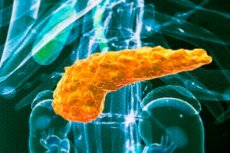Antioxidant gel preserves islet function after pancreas removal
Last reviewed: 14.06.2024

All iLive content is medically reviewed or fact checked to ensure as much factual accuracy as possible.
We have strict sourcing guidelines and only link to reputable media sites, academic research institutions and, whenever possible, medically peer reviewed studies. Note that the numbers in parentheses ([1], [2], etc.) are clickable links to these studies.
If you feel that any of our content is inaccurate, out-of-date, or otherwise questionable, please select it and press Ctrl + Enter.

Researchers from Northwestern University have developed a new antioxidant biomaterial that could make life significantly easier for people suffering from chronic pancreatitis in the future.
Main conclusions of the study
The article “Phase-changing citrate macromolecule combats oxidative pancreatic islet damage, enables islet engraftment and function in the omentum” was published on June 7 in the journal Science Advances. p>
Before surgeons remove the pancreas from patients with severe, painful chronic pancreatitis, they first remove clusters of insulin-producing tissue called islets of Langerhans and transplant them into the liver's vascular system. The purpose of the transplant is to preserve the patient's ability to control blood glucose levels without insulin injections.
Unfortunately, this process destroys 50-80% of the islets, and a third of patients become diabetic after surgery. Three years after surgery, 70% of patients require insulin injections, which is accompanied by a number of side effects such as weight gain, hypoglycemia and fatigue.
New approach to transplantation
In a new study, scientists transplanted the islets of Langerhans into the omentum, a large, flat fatty tissue that covers the intestines, instead of the liver. To create a more favorable microenvironment for the islets, the researchers used an antioxidant and anti-inflammatory biomaterial that quickly turns from liquid to gel at body temperature.
Results of animal experiments
In experiments on mice and primates, the gel successfully prevented oxidative stress and inflammatory reactions, significantly improving the survival and functionality of transplanted islets. This is the first time a synthetic antioxidant gel has been used to preserve the functionality of transplanted islets.
"Although islet transplantation has improved in recent years, long-term results remain unsatisfactory," said Guillermo A. Ameer, who led the study. "Our new synthetic material creates a supportive microenvironment for islet function. When tested in animals, it was highly effective in restoring normal blood sugar levels."
Advantages of the new biomaterial
“With this new approach, we hope that patients will no longer be forced to choose between the pain of chronic pancreatitis and the complications of diabetes,” added Jacqueline Burke, first author of the study.
Role and prospects
For patients living without a pancreas, side effects such as managing blood sugar levels can be a lifelong problem. The islets of Langerhans help the body maintain control of blood sugar levels. Without functioning islets, people must frequently monitor their blood sugar and take insulin injections.
"Living without functional islets places a tremendous burden on patients," Burke said. "They have to learn how to count carbohydrates, dose insulin at the right time and constantly monitor glucose levels. This takes up a lot of their time and mental energy."
Problems with the current method
But unfortunately, the current standard of islet care often leads to poor results. After surgery to remove the pancreas, surgeons isolate the islets and transplant them into the liver through portal vein infusion. This procedure has several common complications. Islets in direct contact with the bloodstream undergo an inflammatory response, more than half of the islets die, and transplanted islets can cause dangerous blood clots in the liver. For these reasons, doctors and researchers sought an alternative transplant site.
New approach using citrate solution
To protect the islets and improve outcomes, Ameer turned to a platform of citrate biomaterials with antioxidant properties developed in his laboratory. In cell cultures, both mouse and human islets stored in citrate gel remained viable much longer than islets in other solutions. When exposed to glucose, the islets secreted insulin, demonstrating normal functionality.
Integration into fabrics
After three months, the body had reabsorbed 80-90% of the biocompatible gel, and by this point it was no longer needed. "What was surprising was that the islets regenerated blood vessels," Ameer said. "The body has created a network of new blood vessels to connect the islets to the body. This is an important breakthrough because the blood vessels keep the islets alive and healthy."
Ameer next plans to test the hydrogel in animal models over a longer period of time. He also noted that the new hydrogel could be used for various cell replacement therapies, including stem cells for the treatment of diabetes.
